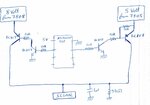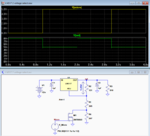aqua_life
Newbie level 6
Hello,
I am developing a circuit to have power and communication on the same wire.
So, I thought about a digital signal that would vary from 5 Volt to 8 Volt.
This way I am able to send signals to another processor and at the same time power that processor.
All working good with the second processor.
Here you can see the type of signal I am generating with a PIC12F processor and two voltage regulators (7808 and 7805).

Here you can see the schematic I have now to produce this signal.

As you can see on the schematic the processor 12F from microchip will turn ON or OFF the outputs to have 5V or 8V at the final Signal. Off course the processor never turns ON both outputs at the same time. Everything is working correctly and the signal is OK.
However when the processor is generating the signal the 7805 output is not 5 Volt as it should. The output is around 5,7 Volts. I have been thinking about this problem and I think this happens because when processor turns OFF 8 Volt and turn ON 5 Volt there is some current flowing to 7805.
Easiest solution was to place a diode on 7805 output. I tried this and then output is ok, at 5 Volt.
But this is not a good solution for me because the diode will take 1 Volt on the 7805 output so the signal will not be 5V - 8V. It would be 4V - 8V and this is not good for me.
Any other solution that might know ?
Many thanks for your help.
I am developing a circuit to have power and communication on the same wire.
So, I thought about a digital signal that would vary from 5 Volt to 8 Volt.
This way I am able to send signals to another processor and at the same time power that processor.
All working good with the second processor.
Here you can see the type of signal I am generating with a PIC12F processor and two voltage regulators (7808 and 7805).

Here you can see the schematic I have now to produce this signal.

As you can see on the schematic the processor 12F from microchip will turn ON or OFF the outputs to have 5V or 8V at the final Signal. Off course the processor never turns ON both outputs at the same time. Everything is working correctly and the signal is OK.
However when the processor is generating the signal the 7805 output is not 5 Volt as it should. The output is around 5,7 Volts. I have been thinking about this problem and I think this happens because when processor turns OFF 8 Volt and turn ON 5 Volt there is some current flowing to 7805.
Easiest solution was to place a diode on 7805 output. I tried this and then output is ok, at 5 Volt.
But this is not a good solution for me because the diode will take 1 Volt on the 7805 output so the signal will not be 5V - 8V. It would be 4V - 8V and this is not good for me.
Any other solution that might know ?
Many thanks for your help.
